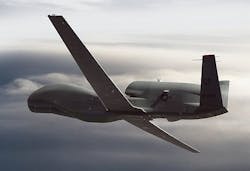Air Force orders three Block 30M RQ-4B Global Hawk UAVs for high-altitude surveillance
Officials of the Air Force Life Cycle Management Center's Global Hawk Program Office at Wright-Patterson Air Force Base, Ohio, are asking Northrop Grumman to build three Block 30M RQ-4B Global Hawk UAVs Enhanced Integrated Sensor Suites and an Airborne Signals Intelligence Payloads (ASIP).
The contract also calls for Northrop Grumman to provide two additional ASIP sensors as retrofit kits. The contract modification brings the value of the original Global Hawk contract to $354.9 million, Air Force officials say.
Global Hawk is a high-altitude, long-endurance (HALE) UAV that provides near-real-time intelligence, surveillance and reconnaissance (ISR) over large areas. The Block 30 Global Hawk carries sophisticated imaging and electronic signals sensors on missions that can exceed 32 hours.
Related: Curtiss-Wright to upgrade flight-control computer for variations of Global Hawk UAV
The Block 30 is configured to carry the Raytheon Enhanced Integrated Sensor Suite (EISS) and the Northrop Grumman ASIP for situational awareness and intelligence-gathering across huge areas of land, Northrop Grumman officials say.
The EISS provides reconnaissance imagery using an all-weather synthetic aperture radar/moving target indicator (SAR/MTI), a high-resolution electro-optical (EO) digital camera, and a third-generation infrared (IR) sensor, all operating through a common signal processor.
The Raytheon EISS allows Global Hawk to survey vast geographic regions with image quality that can distinguish various types of vehicles, aircraft, people, and missiles, even through bad weather, day or night.
Related: Air Force looks to Northrop Grumman for Global Hawk UAV maintenance through late 2014
The EISS transmits imagery and position information from altitudes as high as 60,000 feet with near real-time speed with night vision and radar detection capabilities.
The Global Hawk Block 30 is 47.6 feet long, has a wingspan of 130.9 feet, can fly as high as 60,000 feet, can carry payloads as heavy as 3,000 pounds, and can fly for as long as 32 hours on one load of fuel.
On this contract modification Northrop Grumman will do the work in San Diego, and should be finished by June 2017. For more information contact Northrop Grumman Aerospace Systems online at www.northropgrumman.com, or the Air Force Life Cycle Management Center at www.wpafb.af.mil/aflcmc.
